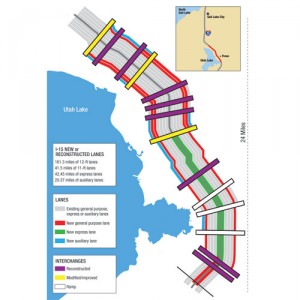
Ned Pelger's blog on construction, design and other weirdness. Email him at ned@constructionknowledge.net
Please help him win his readership competition against his son Lex at the Construction Phone Apps Blog
ENR has a helpful article this week titled Recession’s Realities: The New Normal and How to Win Work. Explaining that the future in construction is unlikely to look like the past, the article hits the normal negatives of low pricing, lagging funding and scarcity of projects. On the positive side, however, they discuss an increase in quality, more functional joint venture partnerships and much more interest in innovation from Owners.
As I’ve been saying for years, these tough times will good for the competent folks and miserable for the those just trying to hang on. The good news? You get to choose to which group you belong.
The ENR article listed the following insert that impressed me:
Winning the Project: Tips from Owners
• Visit the site of the project ahead of time, even if you have to travel.
• Put together a team in which the different cultures mesh. (This strategy is more important than compatible computer platforms.)
• Make certain that every team member you propose will be on the project—and stay.
• Don’t go around, behind or above your official point(s) of contact to get a foot in the door or insider information. Such a move only makes it harder for them to choose you.
• Establish a rapport. Owners say again and again that chemistry is a key factor in selecting a winner.
• Don’t over-Google the people on the owner’s team. They consider it creepy if you know too much about them.
• Treat the administrative staff and the rank- and-file people well. They have more influence than you think.
I recommend you consider these guidelines carefully, regardless of your position in the construction food chain. How could these guidelines be varied to help you better succeed at what you do?
China’s president and party chief since 2002, Hu Jintao, appears to have selected Xi Jinping as his successor. The transition should occur over the next 2 to 3 years. Both men are trained as engineers, as are most of the leaders in China.
The affable Mr. Xi, who’s wife is a popular folk singer, is pictured below.
I hadn’t known that engineers run China, though it makes sense. The focus on efficiency and the concurrent mishandling of people tends to support the generalization that engineers are good with numbers and not so much with people. The amazing economic growth of China clearly has been guided with a focus on efficiency, with an attitude of maximizing exports and minimizing consumption. As expected, this results in great financial position and less than happy citizens.
I understand this striving to maximize efficiency, using that principle as a cornerstone for my business and life. I also understand the negative consequences to forgetting about people and their feelings and needs.
Of course, the generalization about engineers isn’t completely true. All generalizations are wrong (including this one), but there is usually some truth to be found.
When our son Lex was in engineering school, he realized that his geeky high school self was now a college engineering student with much more personality than most of the other engineering students. I shared with him the old proverb, “In the land of the blind, the one eyed man is king.”
So, when you read the stories about China, remember that engineers run their government. It should help you gain a better understanding.
Since I’ve written the six construction phone apps for iPhones, Blackberries and Androids, I had to get one of each of the phones to test the programs. I already had a Blackberry Storm II, so I got an iPhone for TBW and Android for the boy. If you’re thinking about getting a smart phone and work in construction, you’ll probably appreciate my unbiased opinions.
Androids are amazing. Every aspect of the phone works well, especially the feature that lets you create a WiFi hotspot for your laptop (giving you internet access on your laptop anywhere you have a phone signal). Of course if you don’t use a laptop, this feature won’t seem so cool. The buttons on the Androids make the most sense and the system allows you to do several things at one time.
The iPhones are a marvel of simplicity. If you’re not particularly good with tech devices, it may be the best choice for you. I don’t particularly like the single button, which really limits what you can do with the phone. I tend to look at menus and consider options, which are lacking on the iPhone. So the iPhone works as a good, simple product, but doesn’t give the same flexibility as the Android. Also, the AT&T phone network offers spotty coverage and lackluster service. TBW has to stand in one spot in our house to have service.
Blackberries suck. They work OK most of the time, but simply haven’t kept up with the features and options available on the Android and iPhones. I know that most of us in construction have Blackberries, but the trend indicates that our next phone is likely to be an Android.
An article recently noted that Android is the #1 operating system sold in the last six months. That phenomenal growth comes from the great word-of-mouth that Android users are spreading about their phones.
The current market share has Blackberry with 31%, iPhone 28% and Android 19%, but the chart above shows that those market shares are likely to flipflop. If you use a smart phone, what has your experience been?
While reading Professor Toilet’s blog (don’t even ask), I came across a hilarious Home Depot review from a very satisfied toilet customer. I especially loved his comment about his mother-in-law’s “steady diet of broccoli, cabbage and gravel.” I’ve copied the review of the Champion 4 toilet below.
“I love my wife. And she loves her mother. And so when my mother-in-law is in town, we treat her as we would any guest and let her use the bathroom. Over a 7 year period, she has clogged the toilet no fewer than 30 times (often twice in a day) No, this is not a letter to WebMD but rather a note of acknowledgement that the Champion 4 has not only saved my marriage but possibly a woman’s life.
It was after her last visit to my house to offload what I can only assume is a steady diet of broccoli, cabbage and gravel that I decided to take matter in my own hands. Vowing to solve the problem once and for all, I strode in to the local Home Depot and after pausing to price the cost of a tarp, a shovel, a large bag of lye and 7-10 years in federal prison I spoke with a nice man in plumbing. After letting me vent and shed a few tears, he directed me to the Champion 4 toilet.
You know those moments in your life when the world slows down and all the ambient noise gives way and you are filled with a calm feeling of fulfillment? The birth of my children, hitting the game winning double in the state quarterfinals, college graduation and now this. The Champion 4. Read the other reviews that talk about ease of installation, water flow and seat height–they are all true. It is a great toilet and has operated flawlessly for sometime now but to me it is much more. It is so much more.”
I recently got a note from a fellow who was a carpenter and took one of my Construction Supervisor training classes. He’s now finishing up his Mechanical Engineering Technology degree and wants to talk about ways to make a living with that. He’s worked on some patents and is a sharp guy. The age old question, though, how to translate skill and effort into cash.
My son sent me this Pinching Earth photo of a clothespin sculpture in Belgium that got me thinking.
The world is full of niches where creative, hard working people make their mark. Think of the guy who first designed the clothespin. He found a niche that worked well for him. The folks that designed and built the sculpture above (and the Philadelphia Clothespin below) also found niches that worked.

In my own experience, I found a rational way to solve the problem of how to make a living. First, struggle to understand the things I like to do and have aptitude. Next, look at the world and see where money changes hands, try to understand where cash flows. Then I try to see a way to add value somewhere in that cash stream. Finally, the last and most important step, think hard and long about how I will find someone to pay me to add that value (selling).
That process may sound obvious, but I think few people use it. If you are transitional, or want to be, I encourage you to work through the steps in writing. You’ll likely be surprised with what you learn.
Floridians will be voting soon to decide if any changes to local land use plans will need to be approved by a voter referendum. The ballot language states that Amendment 4 “establishes that before a local government may adopt a new comprehensive land use plan, or amend a comprehensive land use plan, the proposed plan or amendment shall be subject to vote of the electors of the local government by referendum.” Blogger Scott Judy of ENR reports that the the statewide annual average for amendments to land-use plans was nearly 8,000 between 2001 and 2005.
Can you imagine the effect the passage of this state constitutional amendment would have on construction? Say you’re an Owner considering all the risks of developing an apartment community, or an industrial park, or even a church. Since site conditions and project needs often vary so widely, it’s fairly common to need some sort of relief from the “One size fits all planning codes”. So before you get too far into the project, you’re told that a voter referendum will be needed to approve your project. To proceed, you’d likely have to spend tens or hundreds of thousands of dollars to complete the design so you could adequately answer all the questions, while knowing the the voters could just vote no.
What would you do? You’d go somewhere else…or do something else. The risk/reward would be so skewed that projects won’t even be proposed. How can people be this stupid?
The folks at Florida Hometown Democracy were kind enough to post a YouTube video to explain.
httpv://www.youtube.com/watch?v=ZWMXPWwrchU&feature=player_embedded#!
We are already a society that hasn’t built a new nuclear plant, chemical plant or quarry in years. Are we going to continue on that trajectory?
We’ve had a few projects stall in recent months. Owners either decide to just wait and see or can’t get financing. Our multifamily apartment projects, though, continue to get approved and keep crews working.
I just came across a good blog post from Boyce Thomson about the strong apartment construction market outlook. All the speakers at this year’s Multifamily Executive Conference agreed on the the positive outlook for apartments for the forseeable future. As home ownership becomes less appealing from a long term investment standpoint and as labor mobility becomes more important in our economy, apartment living looks good.

The executives at the conference spoke of 2011 as a good year for rent growth and Net Operating Income. They also noted that the new apartments being built tend to be sustainable and high-tech.
As you look at where you fit in this crazy construction economy, remember to pay attention to trends like this. It’s much easier to swim with the current than against.
The Construction Industry does a poor job of training people to move up the ranks. 50 years ago, the fellow with the most self motivation would reach out, on his own, to learn the helpful skills to move into supervision or management. He’d watch how his bosses acted and start acting that way. So many things have changed in the past 50 years, but training in construction hasn’t kept pace.
Certainly some firms do a good job of spotting potential construction supervisors and developing training that helps them realize their potential. From what I’ve seen, though, few firms actually do this. Most of the efforts in construction seem to be focused on getting today’s work done. Any extra available time goes into a bit of planning for tomorrow’s work.
Rather than moaning about this odd lack of construction supervision training, though, you should see it as an opportunity. If you have the desire and the will to learn, you can develop your skill set substantially. You can make yourself more valuable and get paid better. You may have to change companies to get paid what you deserve, which seems to be one of the reasons construction firms avoid training. I’ve often heard the old saw, “Why bother to train them, as soon as they get a chance to make $1/hour more, they will jump ship and we’ve wasted our time and effort.”
My advice to you. Train Yourself! Start by understanding that your career (and your income) depend on what you do more than on what your company does. Develop a plan for learning the valuable skills that will make you worth more. Don’t expect your employer to be looking after your best interests…take that job on yourself.
My friend Jim Gravesand works for Bay Area Rapid Transit Authority (BART). We were young engineers working for the same firm 25 years ago and have stayed in touch. Jim enjoys his work at BART, helping put together major transportation projects for one of the most progressive organizations in the world. He sent me the video below that shows the time lapse photography renovation of Metro Line J at 30th and Church Streets.
httpv://www.youtube.com/watch?v=7f6bHg_sO_s
I love seeing the process of demolition, grading/stoning, track installation, testing and paving. The 12 minute video length may discourage you, but I urge you to start to watch and see what you think. The songs were wonderful and work intriguing. Compared to what I did with most of my 12 minute blocks of time yesterday, watching this video was a good investment.
Yesterday, I posted about a public design-bid project with a budget so wrong that the project needed cancelled after it had begun. I closed the post proclaiming that the time for design-build on public projects has come. Today I read an ENR article about a $1.1 Billion Utah highway and bridge project that illustrated one of the problems with public design-build: sore losers and their ability to litigate.
The Utah DOT made a request for proposal for upgrading a 24 mile highway section near Provo.

The design-build finalists were each paid $1.5 Million to prepare their designs and proposals that were judged on budget, highest value, schedule, design and public inconvenience. The Provo River Constructors team (led by Fluor Corp) bested the Flatiron-Skanska-Zachry team by one point.
Apparently the Flatiron-Skanska-Zachry design was elegant and included additional bridges, lanes and pedestrian access. That added scope, however, worried the Utah DOT executive director John Njord:
“They had an elegant design that could only be partly implemented,” Njord says. “It would have to go through an environmental review process. We liked their ideas, but we didn’t know if it could really be achieved.”
Rather than allow the project to be delayed by litigation from the second place finisher, Njord agreed to a $13 Million settlement. While that’s only about 1% of project cost, the political implication of giving away $13 M remains to be seen.
I still believe our society needs to move in the design-build direction, even though some of the steps will be quite challenging.